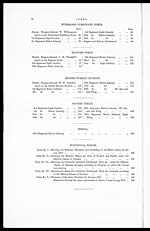Medicine - Institutions > Army health reports and medical documents > Medical and sanitary reports of the native army of Madras > Medical and sanitary report of the native army of Madras for the year 1876
(10) [Page 1]
Download files
Individual page:
Thumbnail gallery: Grid view | List view
![(10) [Page 1] -](https://deriv.nls.uk/dcn17/7499/74991333.17.jpg)
OFFICE OF SURGEON-GENERAL, INDIAN MEDICAL DEPARTMENT,
FORT ST. GEORGE, 26th July 1877.
No. 460.
FROM
SURGEON-GENERAL GEORGE SMITH, M.D.,
INDIAN MEDICAL DEPARTMENT,
Fort St. George,
To
THE SECRETARY TO GOVERNMENT,
MILITARY DEPARTMENT,
Fort St. George.
SIR,
I HAVE the honor to submit to His Grace the Governor in Council the Medical
and Sanitary Report on the Native Army of Madras, for the year 1876.
2. Seasoital phenomena. —The subjoined statement, compiled from tables
obligingly furnished by the Government Astronomer, records the principal meteoro-
logical phenomena as observed at five of the more important military stations of this
Presidency. The rainfall for the year under review was seriously deficient. It
amounted in averages to 16.35 inches, spread over 53.4 days; in 1874, a year of
more than ordinary rainfall, in certain districts 40.66 inches fell at the same
stations in 85.6 days, and in 1875, 24.47 inches fell in 70.4 days. The average
rainfall for the three years 1871—73 inclusive amounted to 46.49 inches. The
highest readings of the thermometer in the shade in 1874, 75, 76 were respectively
98° at Bellary, 98°4 at Trichinopoly, and 110°.2 at Secunderabad. The highest
mean daily ranges during the same years were 22°7 at Bellary, 23°.3 at Secundera-
bad, and 21°.4 at Trichinopoly. The maxima of the sun heat in vacuo and on
grass amounted, during the same year, to 149.3 at Secunderabad and 73.1 at
Trichinopoly (1874); to 149.7 at Secunderabad and 72° at Madras (1875); and to
153.1 at Secunderabad and 72.6 at Trichinopoly (1876). In 1876 both monsoons
were deficient. The seasonal peculiarities of 1876 consisted in a seriously deficient
rainfall combined with a long sustained and high temperature, conditions leading
to failure of crops, to diminished supply of water, to destruction of pasturage, to
impairment of the public health, and to great loss of life both of man and of the
lower animals. The year was one of famine and of pestilence, and, following as it
did an unhealthy year, the results, as regards the civil population, were very
serious. The year closed with " the earth iron and the heavens brass."
Seasonal
phenomena.
1876.
Meteorological Table.
| Stations. | Barometer reduced to 32°. | Thermometer in Shade. | Relative Humidity. | Sun Maximum in Vacno. |
Minimum on Grass. | Rain. | Wind. | |||||||||||||
| Highest Reading. | Lowest Reading. | Extreen Range, Annual. |
Mean Daily Range. |
Mean Pressure. | Highest Reading. | Lowest Reading. | Extreme Range, Annual. |
Mean Maximum. | Mean Minimum. | Mean Daily Range. |
Mean Dry Bulb. | Mean Wet Bulb. | Amount collected. | No. of Rainy Days. | Mean Daily Ve- locity |
General Direc- tions. |
||||
| IN. | IN. | IN. | IN. | IN. | ° | ° | ° | ° | ° | ° | ° | ° | C. | ° | ° | IN. | D. | M. | P. | |
| Bangalore | 27.157 | 26.670 | 0.487 | 0.118 | 26.919 | 98.2 | 48.9 | 29.3 | 85.9 | 64.1 | 21.8 | 73.6 | 64.9 | 64 | 148.1 | 61.6 | 17.35 | 73 | 106 | S. by E. |
| Bellary | 28.693 | 28.143 | 0.550 | 0.141 | 28.380 | 107.7 | 53.4 | 54.3 | 95.1 | 70.6 | 24.5 | 81.4 | 66.0 | 45 | 152.2 | 67.0 | 7.03 | 33 | 169 | South. |
| Madras | 30.144 | 29.531 | 0.613 | 0.126 | 29.835 | 109.1 | 57.6 | 51.5 | 92.2 | 74.1 | 1.8.1 | 81.4 | 73.3 | 68 | 144.5 | 71.8 | 21.60 | 73 | 179 | S. E. |
| Secunderabad | 28.372 | 27.737 | 0.635 | 0.143 | 28.043 | 110.2 | 50.8 | 59.4 | 91.3 | 67.4 | 23.9 | 78.7 | 66.7 | 55 | 153.1 | 60.7 | 15.40 | 57 | 148 | S. by W. |
| Trichinopoly. | 29.868 | 29.321 | 0.547 | 0.150 | 29.584 | 107.9 | 59.6 | 48.3 | 95.4 | 74.0 | 21.4 | 83.0 | 71.9 | 59 | 154.7 | 72.6 | 20.36 | 31 | 192 | S. by E. |
Set display mode to: Large image | Zoom image | Transcription
Images and transcriptions on this page, including medium image downloads, may be used under the Creative Commons Attribution 4.0 International Licence unless otherwise stated. ![]()
| Permanent URL | https://digital.nls.uk/74991331 |
|---|




